当前位置:网站首页>互斥锁、读写锁、自旋锁,以及原子操作指令xaddl、cmpxchg的使用场景剖析
互斥锁、读写锁、自旋锁,以及原子操作指令xaddl、cmpxchg的使用场景剖析
2022-08-04 00:23:00 【cheems~】
互斥锁、读写锁、自旋锁,以及原子操作指令xaddl、cmpxchg的使用场景剖析
前言
本文介绍锁与临界资源与原子操作的的使用场景。
本专栏知识点是通过零声教育的线上课学习,进行梳理总结写下文章,对c/c++linux课程感兴趣的读者,可以点击链接 C/C++后台高级服务器课程介绍 详细查看课程的服务。
临界资源
什么是临界资源
临界资源就是被多个线程/进程共享,但在某一时刻只能被一个线程/进程所使用的资源。
下文以一个经典案例(多线程同时进行i++)介绍三种锁,以及cpu指令集支持的原子操作和CAS。
主线程启动后创建十个线程,并将主线程中的count变量当作参数传入子线程中,也就是说十个线程同时操作一个共享资源count,子线程执行10w次count++ 操作,主线程每隔两秒打印一次count的值。下面来看看加锁与不加锁的区别。
多线程操作临界资源且不加锁
//
// Created by 68725 on 2022/8/3.
//
#include <stdio.h>
#include <pthread.h>
#include <unistd.h>
#include <sys/mman.h>
#define THREAD_SIZE 10
//callback
void *func(void *arg) {
int *pcount = (int *) arg;
int i = 0;
while (i++ < 100000) {
(*pcount)++;
usleep(1);
}
}
int main() {
pthread_t th_id[THREAD_SIZE] = {
0};
int i = 0;
int count = 0;
for (i = 0; i < THREAD_SIZE; i++) {
int ret = pthread_create(&th_id[i], NULL, func, &count);
if (ret) {
break;
}
}
for (i = 0; i < 100; i++) {
printf("count --> %d\n", count);
sleep(2);
}
}
我们预期count最终是达到100w,为什么在不加锁的时候没有达到预期效果?很明显,count++不是原子操作
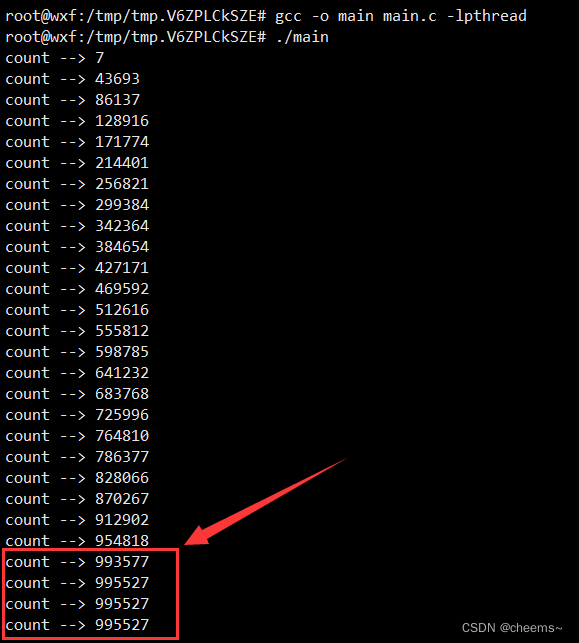
i++不是原子操作,i++对应三条汇编指令
如果i++是原子操作,那么必然会累加到100w,那么i++到底对应着那几步呢?
下面以idx++举例,idx的值是存储在内存里面,首先从内存MOV到eax寄存器里面,然后通过寄存器进行自增,最后再从eax写回到内存中。在编译器不做任何优化的情况下,idx++就对应这三个步骤。
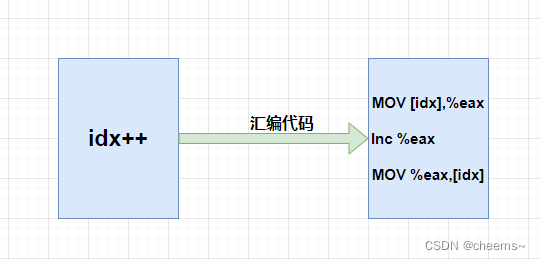
在大多数情况下,程序是这样执行的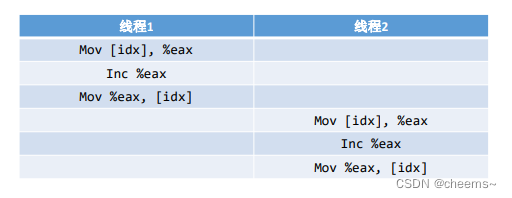
但是也会存在下面这两种情况。线程1首先将idx的值读到了寄存器,然后cpu执行线程2,线程2执行完三步骤后,又回到线程1,线程1接着执行剩下的两步。有人可能会想,两个线程不都执行完了吗?有什么不同?
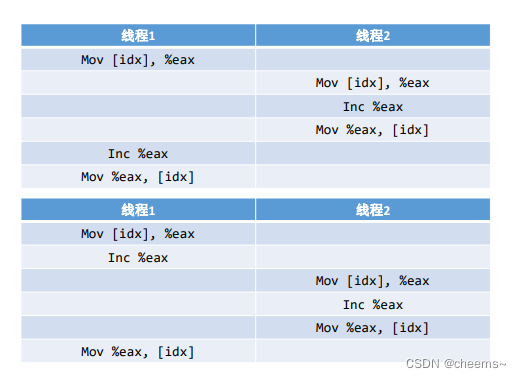
首先,在线程1让出后,线程1的上下文(比如这里的eax),是存储到线程1里面的,线程1恢复后,又将上下文load回去。这里就涉及到yield和resume了,详细介绍看纯c协程框架NtyCo实现与原理的第二节与第三节。 理解了上下文的切换后,就容易理解了,有没有发现,两次++操作,最终会漏加。
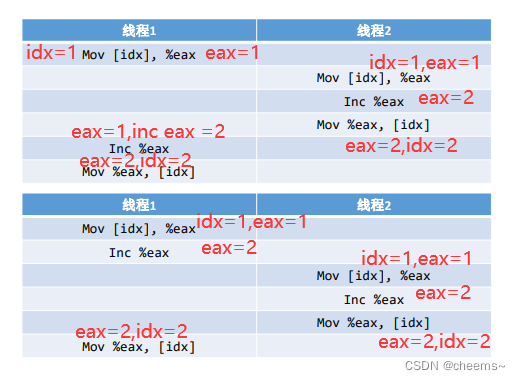
所以在多线程中,操作临界资源时,那么这个临界资源是原子的,那么就不用加锁,要么就必须加锁,否在就会出现上述问题!
那么所谓加锁是什么意思?就是将这三条汇编指令变成一个原子操作,只要有一个线程lock加锁了,别的线程就不能执行进来,直到加锁的线程解锁,别的线程才能加锁。那么这三条汇编指令就是原子的了。下面将介绍3中锁以及2个原子操作。
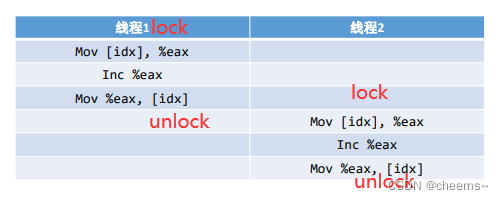
多线程操作临界资源且加互斥锁
下面来看看两种加锁方式,这两种都可以跑了100w,但是这两种加锁的粒度是不一样的,在这个程序中,谁是临界资源?是pcount,而不是while,所以第二种加锁虽然可以跑通,但是它加锁的粒度太大了,就本程序而言,第二种加锁方式这和单线程跑有什么区别?所以我们要对临界资源加锁,不是临界资源的不加锁,掌控好锁的粒度
//正确加锁
while (i++ < 100000) {
pthread_mutex_lock(&mutex);
(*pcount)++;
pthread_mutex_unlock(&mutex);
}
//错误加锁
pthread_mutex_lock(&mutex);
while (i++ < 100000) {
(*pcount)++;
}
pthread_mutex_unlock(&mutex);
//
// Created by 68725 on 2022/8/3.
//
#include <stdio.h>
#include <pthread.h>
#include <unistd.h>
#include <sys/mman.h>
#define THREAD_SIZE 10
pthread_mutex_t mutex;
//callback
void *func(void *arg) {
int *pcount = (int *) arg;
int i = 0;
while (i++ < 100000) {
pthread_mutex_lock(&mutex);
(*pcount)++;
pthread_mutex_unlock(&mutex);
usleep(1);
}
}
int main() {
pthread_t th_id[THREAD_SIZE] = {
0};
pthread_mutex_init(&mutex, NULL);
int i = 0;
int count = 0;
for (i = 0; i < THREAD_SIZE; i++) {
int ret = pthread_create(&th_id[i], NULL, func, &count);
if (ret) {
break;
}
}
for (i = 0; i < 100; i++) {
printf("count --> %d\n", count);
sleep(2);
}
}
可以看到加锁之后,成功达到我们的预期
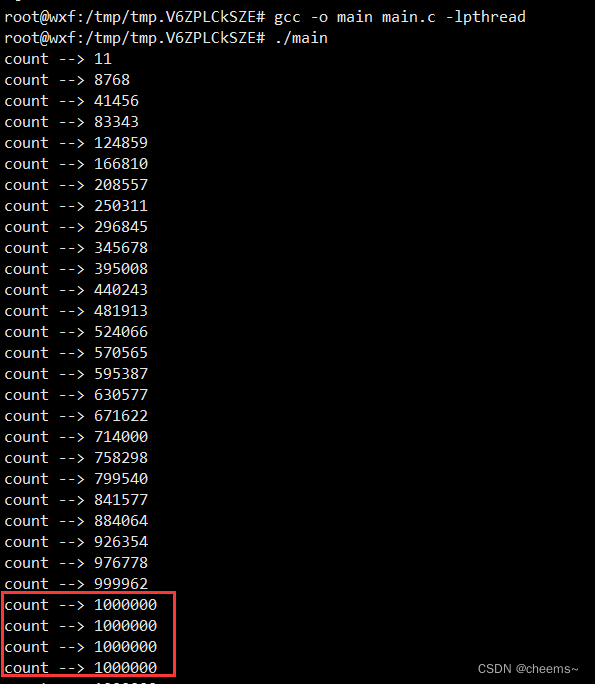
多线程操作临界资源且加读写锁
读写锁,顾名思义,读临界资源的时候加读锁,写临界资源的时候加写锁。适用于读多写少的场景。
- A线程加了读锁,B线程可以继续加读锁,但是不能加写锁。
- A线程加了写锁,B线程不能加读锁,也不能加写锁。
//
// Created by 68725 on 2022/8/3.
//
#include <stdio.h>
#include <pthread.h>
#include <unistd.h>
#include <sys/mman.h>
#define THREAD_SIZE 10
pthread_rwlock_t rwlock;
//callback
void *func(void *arg) {
int *pcount = (int *) arg;
int i = 0;
while (i++ < 100000) {
pthread_rwlock_wrlock(&rwlock);
(*pcount)++;
pthread_rwlock_unlock(&rwlock);
usleep(1);
}
}
int main() {
pthread_t th_id[THREAD_SIZE] = {
0};
pthread_rwlock_init(&rwlock, NULL);
int i = 0;
int count = 0;
for (i = 0; i < THREAD_SIZE; i++) {
int ret = pthread_create(&th_id[i], NULL, func, &count);
if (ret) {
break;
}
}
for (i = 0; i < 100; i++) {
pthread_rwlock_rdlock(&rwlock);
printf("count --> %d\n", count);
pthread_rwlock_unlock(&rwlock);
sleep(2);
}
}
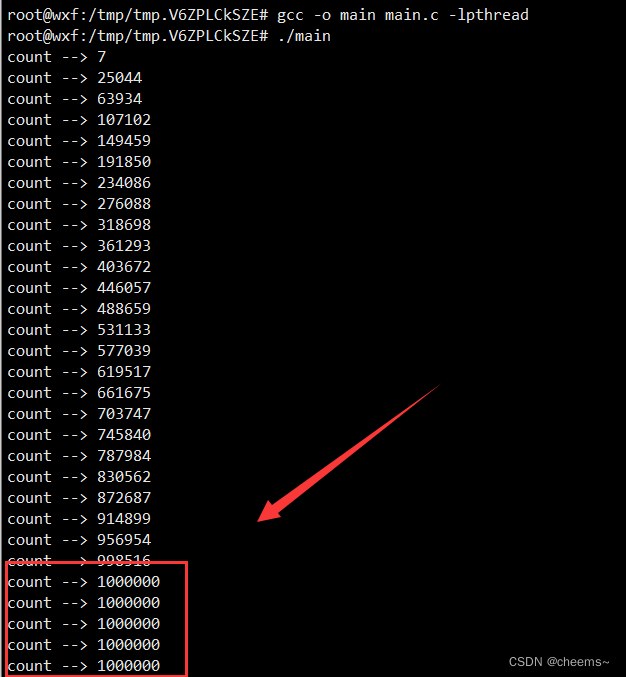
多线程操作临界资源且加自旋锁
spinlock与mutex一样,mutex在哪里加锁,spinlock就在哪加锁,使用方法是一样的,但是其内部行为不一样。那么mutex和spinlock的区别在哪呢?
- 互斥锁在获取不到锁时,会进入休眠,等待释放时被唤醒。会让出CPU。
- 自旋锁在获取不到锁时,一直等待,在等待过程种不会有进程,线程切换。只会一直等,死等。
互斥锁与自旋锁的使用场景下文介绍。
//
// Created by 68725 on 2022/8/3.
//
#include <stdio.h>
#include <pthread.h>
#include <unistd.h>
#include <sys/mman.h>
#define THREAD_SIZE 10
pthread_spinlock_t spinlock;
//callback
void *func(void *arg) {
int *pcount = (int *) arg;
int i = 0;
while (i++ < 100000) {
pthread_spin_lock(&spinlock);
(*pcount)++;
pthread_spin_unlock(&spinlock);
usleep(1);
}
}
int main() {
pthread_t th_id[THREAD_SIZE] = {
0};
pthread_spin_init(&spinlock, PTHREAD_PROCESS_SHARED);
int i = 0;
int count = 0;
for (i = 0; i < THREAD_SIZE; i++) {
int ret = pthread_create(&th_id[i], NULL, func, &count);
if (ret) {
break;
}
}
for (i = 0; i < 100; i++) {
printf("count --> %d\n", count);
sleep(2);
}
}
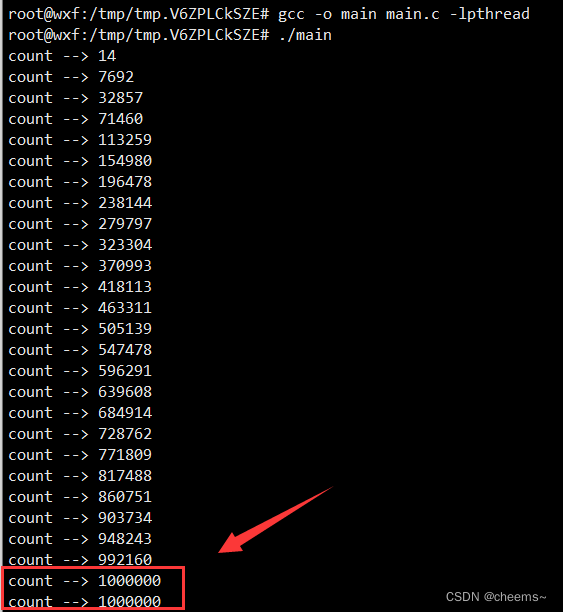
原子操作
我们发现加锁,都是将i++对应的汇编的三个步骤,变成原子性。那么我们有没有办法直接将i++对应的汇编指令,变成一条指令?可以,我们使用xaddl这条指令。
Intel X86指令集提供了指令前缀lock⽤于锁定前端串⾏总线FSB,保证了指令执⾏时不会收到其他处理器的⼲扰。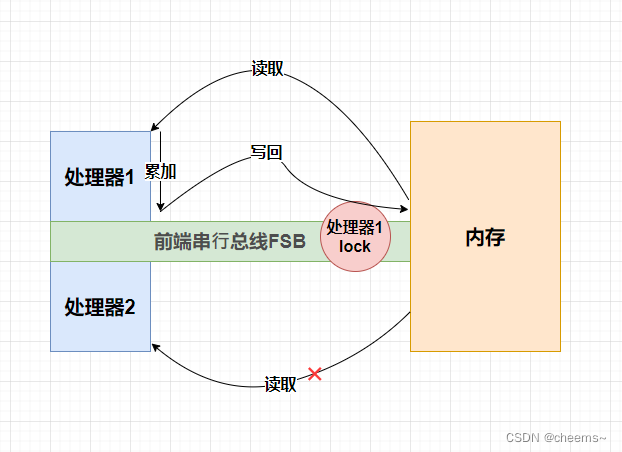
所谓原子操作,它不是某条具体的指令,它是CPU支持的指令集,都是原子操作。比如说CAS,CAS是原子操作的一种,而不能说原子操作就是CAS。
xaddl -----> Inc
- xaddl:第二个参数加第一个参数,并把值存储到第一个参数里
//
// Created by 68725 on 2022/8/3.
//
#include <stdio.h>
#include <pthread.h>
#include <unistd.h>
#include <sys/mman.h>
#define THREAD_SIZE 10
int inc(int *value, int add) {
int old;
__asm__ volatile (
"lock; xaddl %2, %1;"
: "=a" (old)
: "m" (*value), "a" (add)
: "cc", "memory"
);
return old;
}
//callback
void *func(void *arg) {
int *pcount = (int *) arg;
int i = 0;
while (i++ < 100000) {
inc(pcount, 1);
usleep(1);
}
}
int main() {
pthread_t th_id[THREAD_SIZE] = {
0};
int i = 0;
int count = 0;
for (i = 0; i < THREAD_SIZE; i++) {
int ret = pthread_create(&th_id[i], NULL, func, &count);
if (ret) {
break;
}
}
for (i = 0; i < 100; i++) {
printf("count --> %d\n", count);
sleep(2);
}
}
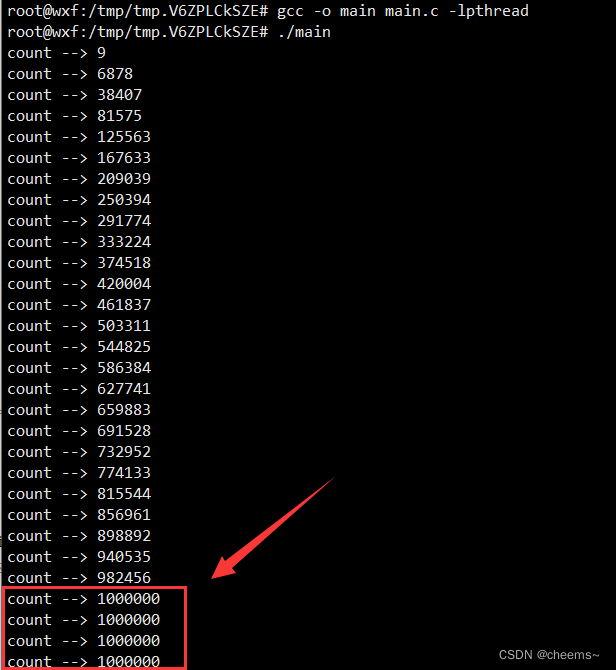
cmpxchg-----> CAS
- CAS:Compare And Swap,先比较,再赋值,翻译成代码就是下面
if(a==b){
//Compare
a=c;//Swap
}
CPU的指令集支持了先比较后赋值的指令,叫cmpxchg。正因为CPU执行了这个指令,它才是原子操作。
// Perform atomic 'compare and swap' operation on the pointer.
// The pointer is compared to 'cmp' argument and if they are
// equal, its value is set to 'val'. Old value of the pointer is returned.
inline T *cas (T *cmp_, T *val_)
{
T *old;
__asm__ volatile (
"lock; cmpxchg %2, %3"
: "=a" (old), "=m" (ptr)
: "r" (val_), "m" (ptr), "0" (cmp_)
: "cc");
return old;
}
三种锁的api介绍
互斥锁 mutex
有两个特殊的api,pthread_mutex_trylock 尝试加锁,如果没有获取到锁则返回,而不是休眠。pthread_mutex_timedlock 等待一段时间,超时了还没获取倒锁则返回。
/* Mutex handling. */
/* Initialize a mutex. */
extern int pthread_mutex_init (pthread_mutex_t *__mutex,
const pthread_mutexattr_t *__mutexattr)
__THROW __nonnull ((1));
/* Destroy a mutex. */
extern int pthread_mutex_destroy (pthread_mutex_t *__mutex)
__THROW __nonnull ((1));
/* Try locking a mutex. */
extern int pthread_mutex_trylock (pthread_mutex_t *__mutex)
__THROWNL __nonnull ((1));
/* Lock a mutex. */
extern int pthread_mutex_lock (pthread_mutex_t *__mutex)
__THROWNL __nonnull ((1));
#ifdef __USE_XOPEN2K
/* Wait until lock becomes available, or specified time passes. */
extern int pthread_mutex_timedlock (pthread_mutex_t *__restrict __mutex,
const struct timespec *__restrict
__abstime) __THROWNL __nonnull ((1, 2));
#endif
/* Unlock a mutex. */
extern int pthread_mutex_unlock (pthread_mutex_t *__mutex)
__THROWNL __nonnull ((1));
读写锁 rdlock
读写锁适用于多读少写的情况,否则还是用互斥锁。
- A线程加了读锁,B线程可以继续加读锁,但是不能加写锁。
- A线程加了写锁,B线程不能加读锁,也不能加写锁。
/* Functions for handling read-write locks. */
/* Initialize read-write lock RWLOCK using attributes ATTR, or use the default values if later is NULL. */
extern int pthread_rwlock_init (pthread_rwlock_t *__restrict __rwlock,
const pthread_rwlockattr_t *__restrict
__attr) __THROW __nonnull ((1));
/* Destroy read-write lock RWLOCK. */
extern int pthread_rwlock_destroy (pthread_rwlock_t *__rwlock)
__THROW __nonnull ((1));
/* Acquire read lock for RWLOCK. */
extern int pthread_rwlock_rdlock (pthread_rwlock_t *__rwlock)
__THROWNL __nonnull ((1));
/* Try to acquire read lock for RWLOCK. */
extern int pthread_rwlock_tryrdlock (pthread_rwlock_t *__rwlock)
__THROWNL __nonnull ((1));
# ifdef __USE_XOPEN2K
/* Try to acquire read lock for RWLOCK or return after specfied time. */
extern int pthread_rwlock_timedrdlock (pthread_rwlock_t *__restrict __rwlock,
const struct timespec *__restrict
__abstime) __THROWNL __nonnull ((1, 2));
# endif
/* Acquire write lock for RWLOCK. */
extern int pthread_rwlock_wrlock (pthread_rwlock_t *__rwlock)
__THROWNL __nonnull ((1));
/* Try to acquire write lock for RWLOCK. */
extern int pthread_rwlock_trywrlock (pthread_rwlock_t *__rwlock)
__THROWNL __nonnull ((1));
# ifdef __USE_XOPEN2K
/* Try to acquire write lock for RWLOCK or return after specfied time. */
extern int pthread_rwlock_timedwrlock (pthread_rwlock_t *__restrict __rwlock,
const struct timespec *__restrict
__abstime) __THROWNL __nonnull ((1, 2));
# endif
/* Unlock RWLOCK. */
extern int pthread_rwlock_unlock (pthread_rwlock_t *__rwlock)
__THROWNL __nonnull ((1));
自旋锁 spinlock
自旋锁最大的特点是,获取不到锁就一直等待,即使CPU时间片用完了也不会发生切换,死等。而上面两种锁不一样,获取不到就会休眠,让出CPU时间片,切换到其他线程或进程执行。
/* Functions to handle spinlocks. */
/* Initialize the spinlock LOCK. If PSHARED is nonzero the spinlock can be shared between different processes. */
extern int pthread_spin_init (pthread_spinlock_t *__lock, int __pshared)
__THROW __nonnull ((1));
/* Destroy the spinlock LOCK. */
extern int pthread_spin_destroy (pthread_spinlock_t *__lock)
__THROW __nonnull ((1));
/* Wait until spinlock LOCK is retrieved. */
extern int pthread_spin_lock (pthread_spinlock_t *__lock)
__THROWNL __nonnull ((1));
/* Try to lock spinlock LOCK. */
extern int pthread_spin_trylock (pthread_spinlock_t *__lock)
__THROWNL __nonnull ((1));
/* Release spinlock LOCK. */
extern int pthread_spin_unlock (pthread_spinlock_t *__lock)
__THROWNL __nonnull ((1));
三种锁的使用场景
比如说读一个文件,就使用mutex。而如果是简单的加加减减操作,就是用spinlock。如果系统提供了原子操作的接口,对于i++这种操作来说,用原子操作更合适。
spinlock:临界资源操作简单/没有发生系统调用/持续时间较短(自旋锁就主要用在临界区持锁时间非常短且CPU资源不紧张的情况下,等待时消耗cpu资源较多,自旋锁一般用于多核的服务器。)
mutex:临界资源操作复杂/发生系统调用/持续时间比较长
- 临界区有IO操作
- 临界区代码复杂或者循环量大
- 临界区竞争非常激烈
- 单核处理器
- 原子操作:使用场景很小,必须需要CPU的指令集支持才行。(原子操作适用于简单的加减等数学运算,属于粒度最小的操作。比如往链表里增加一个结点,可以做出原子操作吗?不行,因为CPU指令集没有同时多个赋值的指令。cas 多线程同时竞争的时候效率并不会特别高,如果互斥锁和自旋锁能满足要求了尽量不要用cas)
原子操作的接口
c
对于gcc、g++编译器来讲,它们提供了⼀组API来做原⼦操作:
type __sync_fetch_and_add (type *ptr, type value, ...)
type __sync_fetch_and_sub (type *ptr, type value, ...)
type __sync_fetch_and_or (type *ptr, type value, ...)
type __sync_fetch_and_and (type *ptr, type value, ...)
type __sync_fetch_and_xor (type *ptr, type value, ...)
type __sync_fetch_and_nand (type *ptr, type value, ...)
bool __sync_bool_compare_and_swap (type *ptr, type oldval type newval, ...)
type __sync_val_compare_and_swap (type *ptr, type oldval type newval, ...)
type __sync_lock_test_and_set (type *ptr, type value, ...)
void __sync_lock_release (type *ptr, ...)
详细⽂档⻅:https://gcc.gnu.org/onlinedocs/gcc-4.1.1/gcc/Atomic-Builtins.html#AtomicBuiltins
c++
对于c++11来讲,也有⼀组atomic的接⼝:https://en.cppreference.com/w/cpp/atomic
边栏推荐
猜你喜欢
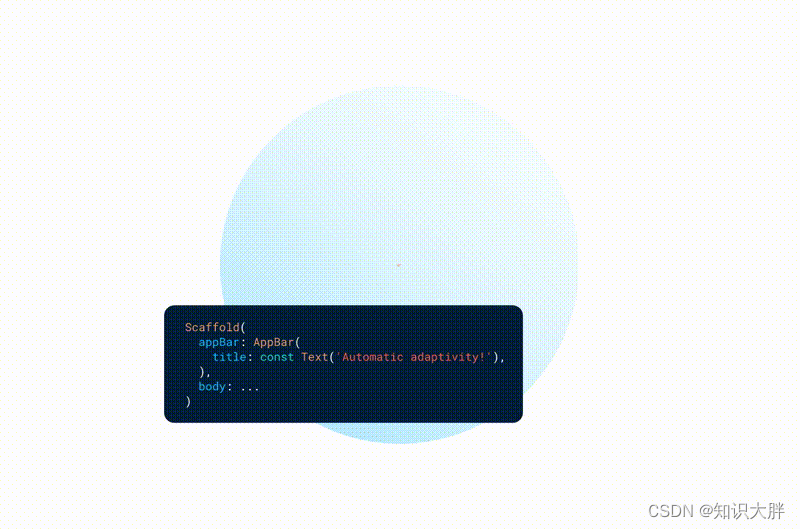
Why Flutter Flutter of tutorials is the best choice for business?

智能管理PoE交换机
![[Miscellaneous] How to install the specified font into the computer and then use the font in the Office software?](/img/15/23b0724f9c9672c61b91320f1b84d8.png)
[Miscellaneous] How to install the specified font into the computer and then use the font in the Office software?
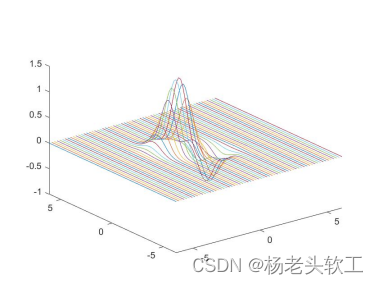
MATLAB三维绘图命令plot3入门

微服务的简单介绍
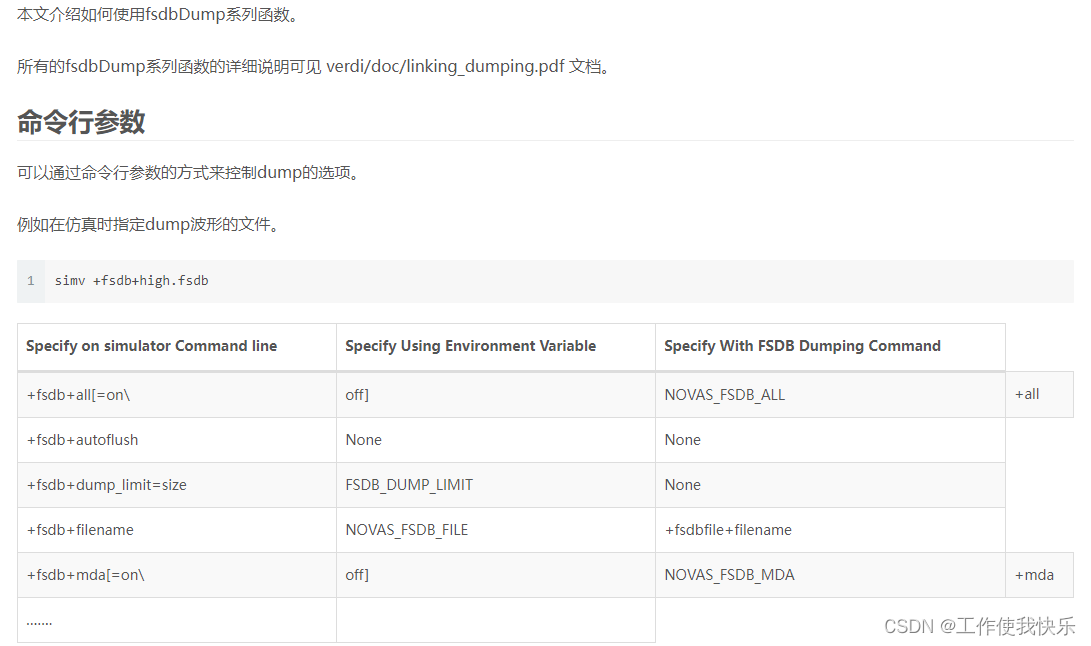
fsdbDump用法

C语言 函数递归

nodeJs--async/await

教你如何定位不合理的SQL?并优化之

The Beijing E-sports Metaverse Forum was successfully held
随机推荐
Prometheus监控Harbor(二进制版)
教你如何定位不合理的SQL?并优化之
corn表达式 具体详解与案例
Read FastDFS in one article
rsync basic usage
Salesforce的中国区业务可能出现新变化,传言可能正在关闭
Mvc、Mvp和Mvvm
求解同余方程 数论 扩展欧几里得
The curl using guide
POE交换机全方位解读(上)
【详细教程】一文参透MongoDB聚合查询
A Preliminary Study of RSS Subscription to WeChat Official Account-feed43
因为一次bug的教训,我决定手撕Nacos源码(先撕客户端源码)
咱们500万条数据测试一下,如何合理使用索引加速?
pcl点云数据 转化为 Eigen::Map
MATLAB三维绘图命令plot3入门
孙宇晨:Web3.0和元宇宙将协助人类更加全面地进入网络世界
高斯推断推导
FastDFS 一文读懂
代码重构:面向单元测试